Reproduced by permission of Aeroplane magazine.
From «Aeroplane Monthly», June 1996.
Reproduced by permission of Aeroplane magazine. ![]() www.aeroplanemonthly.com
www.aeroplanemonthly.com

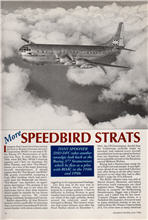
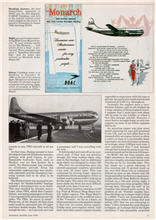
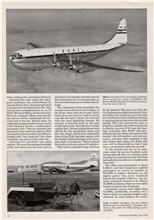
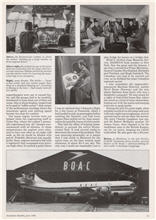
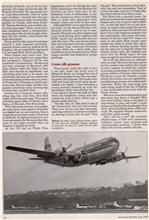
 |
| Heading picture, the first Stratocruiser registered to BOAC was the fleet flagship, G-AKGH Caledonia, seen here in the original natural metal finish adopted by the airline. It passed to Transocean in August 1958, becoming N137A. |

Isuppose that I must have been among the first in British Overseas Airways Corporation (BOAC) to see and to fly the Boeing 377 Stratocruiser of early post-war days. It came about in May 1948, when Bill May (BOAC's training captain) and I flew our chairman, Sir Miles Thomas, and other "Nut-House" bosses, on a tour of the major American aircraft manufacturers. (I should explain that the "Nut-House" was BOAC HQ, grossly overstaffed, occupying a huge office building which had previously been the Simmonds nut factory. "Nut-House" was, therefore, an appropriate description.) The purpose of our trip to the USA was to see what the Americans had in their shop windows which might be suitable for our future transatlantic services. We visited Boeing, Lockheed, Douglas and Convair.
Rather shamefully, all that Britain's premier airline could offer its chairman was a converted Consolidated B-24 Liberator bomber with about a dozen seats rigged up in its unpressurised fuselage.
Our first stop of the tour was at Wichita, Kansas, where I was confronted by a unique problem. I had no difficulty in finding Wichita in good weather, but it took me some time to find out which of the eight airfields, dotted around the relatively small city, belonged to Boeing. This bizarre situation had arisen because, soon after the Pearl Harbor attack on December 7, 1941, the US Government, fearful that the Californian airfields might be attacked, had ordered every aircraft manufacturer to set up a plant well away from any American coast. All had chosen to assemble aircraft on the flat plains around Midwest Wichita.
Boeing had a Stratocruiser ready for us to flight test and sample. It was lightyears ahead of our converted Liberator and, after flying to all the other manufacturers to see what they had to offer, BOAC's order for 377s followed.
The BOAC Atlantic base was still at Dorval Airport, Montreal, and before deliveries could commence our chief engineer there, "Digger" Ifold, went to Boeing to examine the forthcoming Stratocruisers. Digger was a friend of mine, and I asked him for his views. "Captain (Digger spoke slowly, in a Yorkshire-like manner), A've never seen so many electrical circuits in one aircraft in all my life. (Pause). Come to think of it, I've never seen so many electrical circuits in any TWO aircraft in all my life."
| Right, part of a brochure advertising BOAC's new Monarch seruiee. "A royal welcome awaits you on The Monarch ... with service fit for a king", it proclaimed. Every passenger was given a "Speedbird Overnight Bag", and the ladies also received an Elizabeth Arden Beauty Kit |  |
| Below, Caledonia taxies in at Heathrow on November 18, 1949, at the end of her delivery flight. Handed over at Seattle on November 15, she then made her acceptance-cum-proving flight, which terminated at BOAC's new maintenance base at Filton, Bristol. |
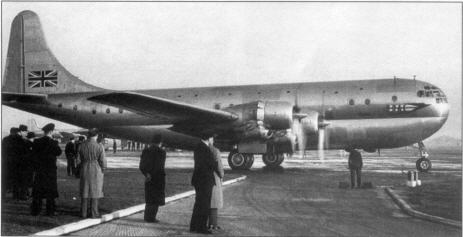 |
At that time, Boeing seemed to have developed a hatred of hydraulic systems, perhaps with good reason, as nonflammable hydraulic fluid, such as Skydrol, was not then known. As a result, the Stratocruiser was virtually an all-electric aircraft. Even the retractable undercarriage was electrically operated, and the emergency lowering system had to be seen to be believed.
The Stratocruiser was unusual in several ways. Its "double-bubble" fuselage enabled a downstairs bar to be fitted. This was reached by circular stairs. Later, when TWA, which flew Constellations, was losing passengers to Strats, it was reputed to be advertising over the radio: "Fly TWA. No stairs to climb!". Thirty-two of the Strat's 40 first-class seats could be converted into 16 upper and lower double bunks. They were big enough for two - as I can aver, as I was a passenger and I was travelling with my wife.
It both landed and took off on its nose-wheel and, if that was not peculiar enough, the wing leading edges, adjacent to the fuselage, had an additional strip which was designed to reduce lift!
The first two peculiarities gave the aircraft passenger comforts unrivalled even now, 50 years later. This was enhanced by having large, spacious washrooms where passengers, if they so wished, could undress before tucking up for the night. The other two unique features made the Strat the most difficult aircraft to fly that I ever sat in.
The airliner had four enormous 3,500 h.p. Pratt & Whitney Wasp Major fourrow radial engines. The Wasp Major's 28 cylinders gave it the unofficial name of the "Corncob". As far as I know, no other manufacturer attempted to design a four-row air-cooled piston engine. Unlike most aero-engines which, with time, have their power outputs steadily upgraded as experience with the type is gained, this particular beast started and remained at 3,500 h.p. throughout.
Generally the engines were a troublesome feature, and we all chalked up a large number of three-engined hours. I suppose that I must have had about 100 at least in the 4,500hr in which I flew this strange aircraft. However, I never had to struggle home on only two engines, as some of my fellow captains had to do.
An annoying aspect was that strict petrol rationing for cars still persisted in the UK, and, as fuel often had to be dumped after an engine failure to allow a return to base at a permissible landing weight, we were chucking overboard, on average, about 2,500gal each time. I once calculated that I had dumped enough fuel to keep me going in my (economical) small car for the next 250 years.
As BOAC did not then possess any flight simulators, the early pilots were sent on a lengthy simulator course with Pan Am at its La Guardia base. This has made me a great advocate of this training aid. It proved itself on my very first Strat trip in command. Almost as soon as the wheels had left the ground after my first ever maximumweight take-off, from Keflavik Airport, Iceland, on a vile and stormy night, I experienced a run-away propeller. After having been "through the mill" at La Guardia, this seemed quite normal. No problem at all. "Feather number four. Ease the flaps up in stages while I climb to 1,000ft. Carry out prescribed drill. Request area where to dump fuel and advise ATC that we are returning to base." I then awaited the next disaster to happen, as it always did in the flight simulator. I was pleasantly surprised when nothing else calamitous followed.
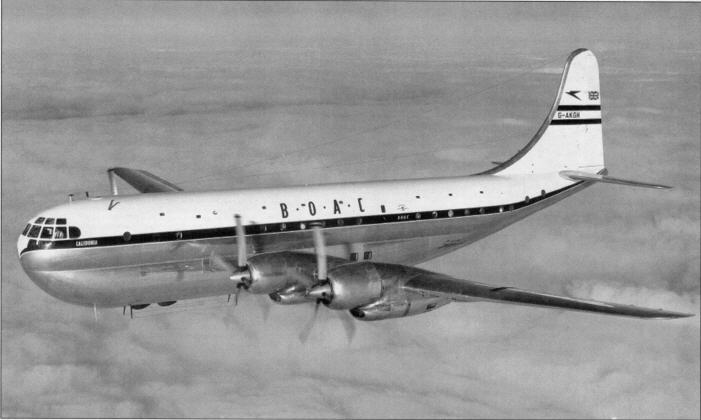 |
| Above, the smart livery eventually applied is shown in this later study of Caledonia. The famous BOAC Speedbird emblem was moved from the nose to the fin. |
Lowering the gear using the emergency procedure was extraordinary by any standards. First, the passengers had to be got out of the downstairs bar. This was no easy accomplishment as, on all BOAC Monarch flights, drinks were free. Then the engineer officer removed the big mirrors which constituted the forward end of the bar. Behind these, he unhitched a huge portable electric motor which looked a bit like a roadworker's pneumatic drill. This he inserted into the motor of one undercarriage leg. With this leg driven down and the aircraft proceeding with "one hung low", the same treatment was given to the other leg.
 |
Left, G-AKGJ Cambria, the first BOAC Stratocruiser to visit Piarco, Trinidad, seen there on November 16, 1954, during a proving flight. |
Lowering the nosewheel was much simpler. You sent the strongest member of the crew down into the nose, and he unlocked a few catches and then heaved the nosewheels out. It took strength, as the nosewheel leg was incredibly stoutly made.
The robustness of the nosewheel leg was proved on almost every landing, as the Strat, when near the ground, had a mind of its own and we used to arrive (one did not land a Strat; one arrived) with the most appalling thumps. No amount of heaving back on the pole would induce the mainwheels to make contact first. Various explanations were offered for this peculiarity. Some said that the wings, which were essentially those of the B-29, had been mated with the double-bubble fuselage at the incorrect angle of incidence. Others pinned the blame on the pernicious lift-spoilers.
Why build a splendid wing and then fit lift spoilers? The story was that the Civil Aeronautics Administration (CAA: the FAA-to-be) would not give the type its Certificate of Airworthiness because a wing was apt to drop when the aircraft stalled. The CAA wanted the nose to drop first, and the only swift remedy was to destroy an area of lift near the fuselage. Ironically, after BOAC had operated the type for about nine years it was decided that lift-spoilers were not necessary, and they were removed. I was then flying later types, but those who were still on Strats told me that it was then a much better-behaved aircraft.
As the aircraft also ran on its nosewheel alone for several hundred yards during take-off, this, too, could be quite exciting in a strong crosswind. The huge tail made the aircraft try to weathercock into wind.
The cabin was pressurised at about 6.41b/in², and this would have enabled passengers to travel in comfort at 30,000ft or higher. However, as the engine power was never increased beyond the original 3,500 h.p., the aircraft remained limited to an official 25,000ft maximum, where we were often tossed around in the cloud-tops.
 |
| Above, the Stratocruiser cockpit, in which the author "chalked up a large number of three-engined hours". |
 |
| Above right, the cocktail lounge on the lower deck was connected with the upper deck by a circular stairway. Hidden behind the mirrors was the electric motor for lowering the mainwheel legs in an emergency. |
Personally I never went higher than 31,000ft, unofficially, of course, but I believe that even greater heights were attained. At such heights the turbo superchargers were apt to exceed limits, and the gauges had to be carefully monitored to keep them out of their red zones. Also at those heights, respect had to be paid to "coffin corner": that corner of the performance envelope where the maximum speed and stalling speed become too close for comfort.
Our many engine worries were not helped when the engineering staff at Goose Bay, where the coldest I personally experienced was -40°, became overenamoured with oil dilution. In those temperatures the engines were reluctant to turn over after an all-night cold soak, so the oil would be diluted with petrol. Probably Montreal was equally guilty. Soon, engines started to fail with a regularity that surpassed even previous high rates. It reached a point where I was so alarmed that I delayed a flight for a few hours at Prestwick, where I had landed to pick up passengers before tackling the Atlantic, and had every engine filter pulled out for close examination for possible traces of white metal.
| Right, sweet dreams. The berths - "seven inches wider and two inches longer than those in a standard sleeping car", according to Boeing at the time - had ample room for two adults. |  |
This had the effect of helping immediately to ground the entire Stratocruiser fleet. It took several weeks to determine the cause of the problem. This was annoying personally, as it meant that I was stuck in Montreal for the entire time, on the then miserly meal allowance of about $3-4 per day. The only way I could eat reasonably was to play bridge for money at a bridge club.
BOAC's all-first-class Monarch Service, BA509/510 from London to New York, flew the great and the famous. I see that I carried five Prime Ministers;, those of Canada, New Zealand, Barbados and Trinidad, and Hugh Gaitskell. The Canadian one had to be carried sub rosa, as he disliked the noisy Canadian national carrier.
I also remember the impeccablymannered Marlene Dietrich, author Nevil Shute (Norway) and the star skater Barbara Anne Scott, who was a delightful young girl. We were stuck for a night at God-awful Goose Bay, where she acted as a kind of extra stewardess, helping out with the meals and keeping everyone in good spirits.
During the still of a quiet night, other notables would sit in the jump-seat and, with only slight encouragement, start to unwind and to tell me their life stories. The actor Charles Laughton was one, and Sir Robert McAlpine another. Sir James Dunn, then reputed to be the wealthiest man in the British Empire, sat for six hours, keeping me totally enthralled. He also gave me a 50-year old bottle of Scotch, one of two he was carrying. The other was for his idol, Sir Winston Churchill. He was going over for Lord Beaverbrook's 75th (or some such) birthday. I learned that the pair of them were once a couple of young lads together in Canada, both stony broke! Sir Thomas Beecham was another fascinating passenger. There must have been something about a transatlantic crossing above the clouds at night, other than the free drinks, which freed the mind and tongue.
| Below, at Heathrow in the late Forties, G-ALSC Centaurus shows another unusual feature of the breed: a sideways-folding fin and rudder to facilitate hangarage. |
 |
Flying still had the aura of mysticism around it that inspired poeticallyinclined writers such as Antoine de St Exupéry, who so masterfully expressed it in his book Wind, Sand and Stars.
Other flights were sheer hell. The Strat had even slighly less range than the competitive Douglas DC-6s and Lockheed Constellations. Westbound non-stop crossings to Montreal, 200 miles shorter than the flight to New York, were beyond its capabilities, and refuelling stops had to be made. An advertised non-stop service sometimes involved as many as three stops en route, at Prestwick or Shannon to uplift maximum fuel, then at either Gander (frequently covered by early morning fog) or Goose Bay and New York.
Iceland was a frequent transit refuelling stop, but, even then, New York might still be beyond range. This meant refuelling again either at Sydney, Nova Scotia, or Moncton, New Brunswick.
When Bermuda services were added, the same basic route applied. If Gander was fogged out, as was common, then it would mean having to make a first stop at Keflavik. It required stamina to convince passengers for Bermuda that they were in the right aircraft when we stopped at Iceland en route.
As the UK had no Flight Time Regulations until the British Air Line Pilots' Association took the Minister for Aviation (as there then was) to the Industrial Court of Arbitration, it was not too unusual to arrive in New York 16hr or more after departure from London. Once I was 21hr on this route.
Although BOAC never used the southern route, via the Azores, Pan-Am, with identical aircraft, used to try it occasionally. We used each other's spares and I can recall having three engines with BOAC motifs and paintwork and one with Pan-Am's. This was not too noticeable, but I once had to borrow, in Iceland, an engine from American Overseas Airlines which, for a short while, also used Strats on an Atlantic service. Their engine nacelles had distinctive orange markings.
Green silk pyjamas
Those bunks could tell a tale or two! I can still recall the lovely eyes of Elizabeth Taylor as I helped her out of bed from her upper berth. She was wearing green silk pyjamas amas. The bunks were wide and long, and could easily accommodate two adults. I once disturbed a young steward shacked up with the stewardess. Both were off duty, but ... I was about to throw the book at them when the handsome young man disarmed me with a story which only a genius could contrive.
"It's like this, sir. The chief is one of the homosexual ones [we had several. They were all our very best stewards], and I figured that I could best avoid him by sharing a bunk with the girl." Note "the girl". We carried three or four stewards, but only one stewardess. Now, of course, the cabin crew of a 747 looks like the entire chorus from Drury Lane.
The Strat was a peculiar beast. Its pilots never knew for certain what might happen next, but we never had to ditch one, as Pan-Am had to do on two occasions. An engine once caught fire, burnt itself out, then conveniently fell off, and there were a few landing accidents (not too surprisingly). That great first gentleman of the air, Capt O.P. Jones (we were on the same Strat course) later landed one short at Goose Bay, fortunately without hurting anyone. Next day he went out to examine where his wheels' marks were. He resigned and never flew for BOAC again. He had done enough for his airline and country.
All in all, the Strat was an unforgettable aircraft. However, she was a great girl for comfort and, luckily, flew nicely on three engines. At times she could be rewarding, perplexing, or vicious but forgiving. Golfers will know what I mean. Flying her across the Atlantic, a route always beyond her natural capabilities, provided some anxious, but seldom dull, moments. When the long-range jets came along, much of the fun of finding a way across that ocean went with the Strats' demise.
Who now cares about temperature and dew point near dawn at Gander? Who now tries "sailing" along on the backs of depressions to gain tailwinds? I recall being over Hudson Bay, heading for New York, while benefiting from a 50kt tailwind. We skippers became meteorologists first, pilots second.
Did I call her a girl? She certainly shared many of that sex's pleasures, comforts, virtues, vices, vexations and unpredictable qualities. I doubt that there will ever be another like her.
| Below, the other major Stratocruiser operator was Pan-Am; N1025V Clipper America is seen here on July 27, 1949, shortly after completion. |
 |